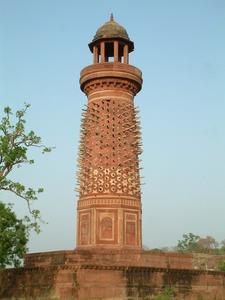Advertisement

 Hiran Mihar
Hiran Mihar
Unusual tower studded with stone tusksWe caught an Agra-bound bus at a junction close to our guesthouse in order to reach
Fatehpur Sikri, which is actually at very close distance from Agra (37 km). Though the bus was crammed, the ride was bearable because it was short. There we took a horse-cart to our destination, passing impressive fortifications of the old Moghul city. For the first time we had an air cooler in our room, an instrument to cool the air by means of water. A big metal box protrudes from the room, there is a kind of frame at the bottom, the three sides outside the room have metal grids and beneath them mats of coir. A ventilator blows the warm air from outside through this "curtain of water", where it is cooled down and blown into the room. The whole cooling system emits quite intensive noise, so we only turned it on when we were not sleeping, but it is very effective and much healthier than air condition, which we always avoid. Klaudia was still very weak, but she managed to see the attractions by making many breaks and sitting in the shade, while Stephan was taking pictures.
Fatehpur Sikri was the capital

 Elephant Gate
Elephant Gate
Ceremonial entrance to the palace quarters guarded by stone elephantsof Akbar, the third and greatest of the Moghul emperors from the second half of the 16th century. Akbar was unhappy because he did not have an heir and visited many holy men so that they would pray for a son. Sheikh Salim Chishti from the village of Sikri told the emperor that he would have three sons, and when the prophecy was fulfilled in 1570, Akbar was so impressed that he resolved to build an entirely new capital there in honour of the saint. During the following 14 years a new city appeared on the hill where the sheikh lived - "Fatehpur" (town of victory) added to the name of the old village , "Sikri". Not long after the last finishing touches were made, the court left again, probably due to the failure of water supply. The city was abandoned by the early1600s, but its red sandstone buildings are perfectly preserved.
Outside the Royal Palace complex, the
Jami Masjid is situated. Built in 1571-72, this is one of the largest mosques in India. Still size has nothing to do with beauty, and this mosque is sublime. Already the two gates are a fine example of the artistry and

 Caravanserai
Caravanserai
Caravanserai to accomodate travellers, tradesmen and guards, with the Jami Masjid in the backgroundcraftsmanship the whole building conveys. There is abundant use of stone inlay and fine forms. Inside the huge congregational courtyard, you find several buildings, a big dome painted in Persian style or the mihrab adorned with carving, inlay work and painting. Undoubtedly the finest building is the tomb of the sheikh, a masterpiece in brilliant white marble. The fine jali screens are highly decorative, while the carved pillar bases are stunning pieces of craftsmanship. Both Hindu and Muslim women pray at the saint's shrine, hoping for the parenthood Akbar was blessed with, and we had this idea, too.
The day we arrived, we spent the afternoon walking around outside the Royal Palace and took a pathway through the
Hathipol (Elephant Gate), which used to be the ceremonial entrance to the palace quarters, guarded by stone elephants. On this pathway we passed the
caravanserai around a large courtyard and further on to the
Hira Minar, an unusual tower studded with stone tusks, thought to commemorate Akbar's favourite elephant. Stephan climbed up the spiral staircase and had a very good view, Klaudia decided to save her energy since she had not yet fully recovered. We enjoyed this walk very much, it

 Jami Masjid - Triumphal Gate
Jami Masjid - Triumphal Gate
The high gate is approached from the outside by a flight of steps which adds to its grandeurwas off the main tourist track and away from the crowds (actually we were the only tourists around).
The
Royal Palace consists of all the building we have already encountered in the forts we visited before. As a vital part of court life, you find the Hall of Public Audience as well as the Hall of Private Audience, the first one with a pavilion containing the emperor's throne, to which he acceded without being seen. The Hall of Private Audience is a single room with a unique circular throne platform. Akbar's guests would sit along the walls of the balcony connected to the Throne Pillar by screened 'bridges", a really unique feature. Of course, houses for Akbar's several wives as well as his private chambers and a beautiful palace for the emperor's Prime Minister are not missing, all of them exquisite buildings with finely carved balconies and ornated with reflecting glass or filled with rich carpets, hangings and cushions. We were lucky to spot a couple of Egyptian vultures and their nest on one of the balconies, while Stephan was away to take pictures, Klaudia enjoyed the sight a lot. Akbar, though being Muslim, was open to Buddhism, Christianity

 Triumphal Gate from the inside
Triumphal Gate from the inside
The small chhattris on top still show some Hindu influence on early Moghul architecture in Indiaand the Hindu faith, and in Fatehpur Sikri he integrated different decorative techniques from all religions: a lotus shaped pillar (a Hindu and Buddhist motif), the Royal Umbrella which is Hindu and the Islamic Tree of Life. Although in our times we cannot imagine how life on a 16th-century Moghul court could have been, then buildings that are left are able to transmit an aura of grandeur and pleasure. Fatehpur Sikri is well worth visiting and we are glad to have seen it.
Advertisement
Tot: 0.422s; Tpl: 0.015s; cc: 33; qc: 164; dbt: 0.2478s; 1; m:domysql w:travelblog (10.17.0.13); sld: 1;
; mem: 1.7mb


























ankita
non-member comment
ummmmmmm
fabulous fantastic beautiful sensible